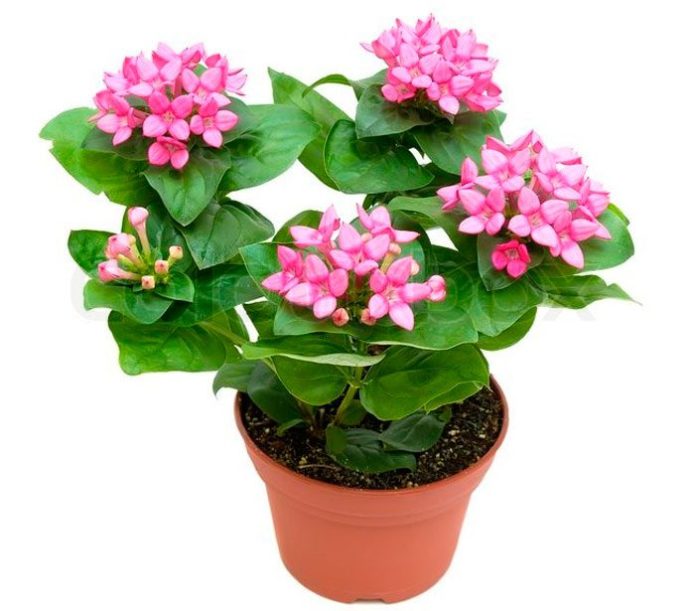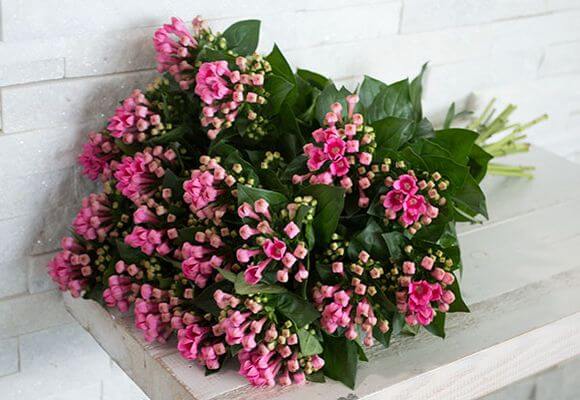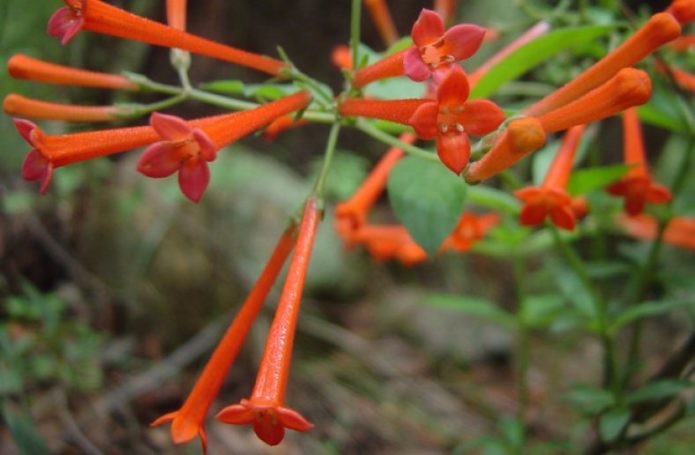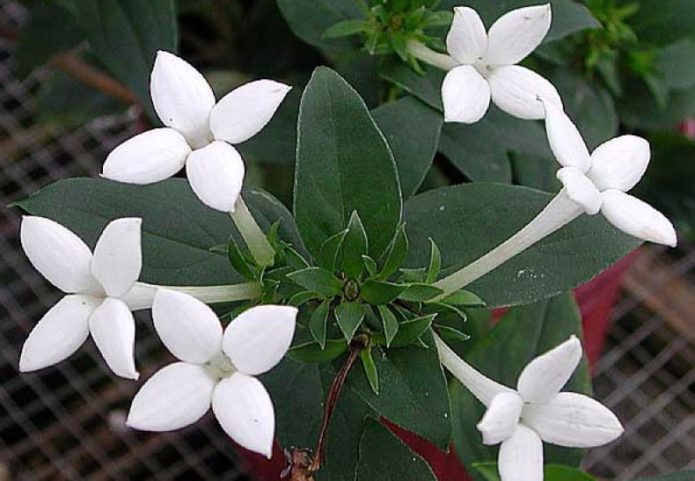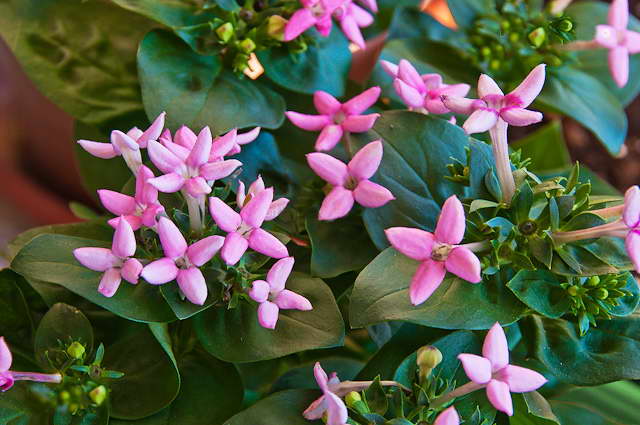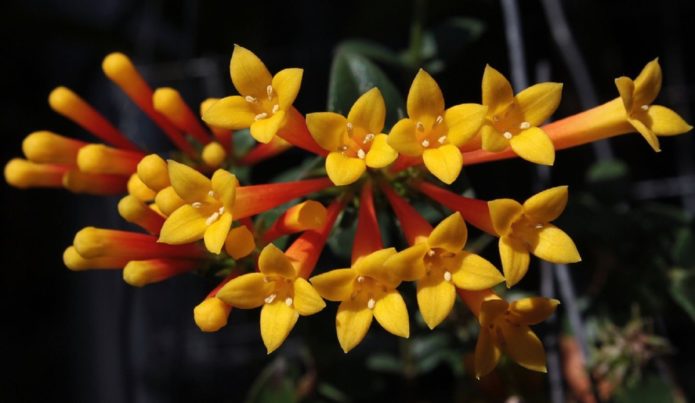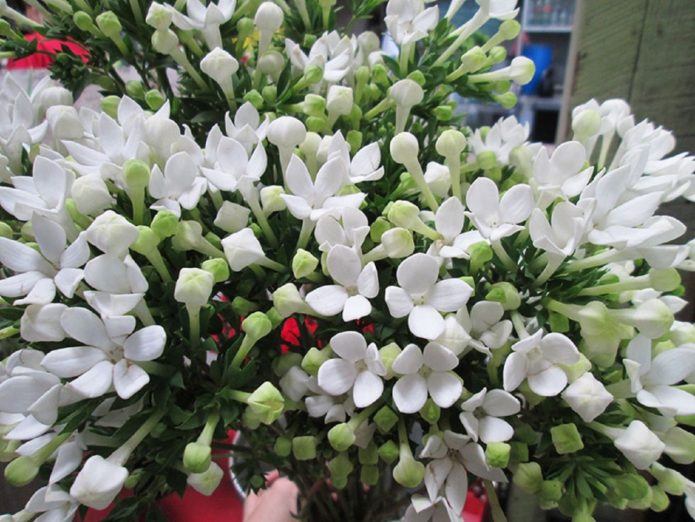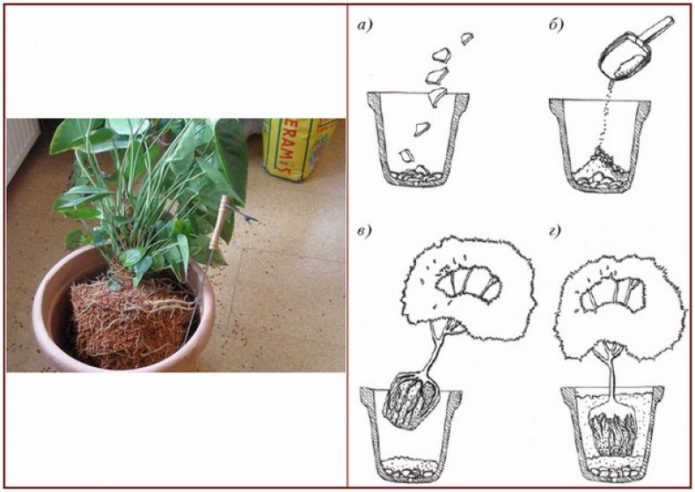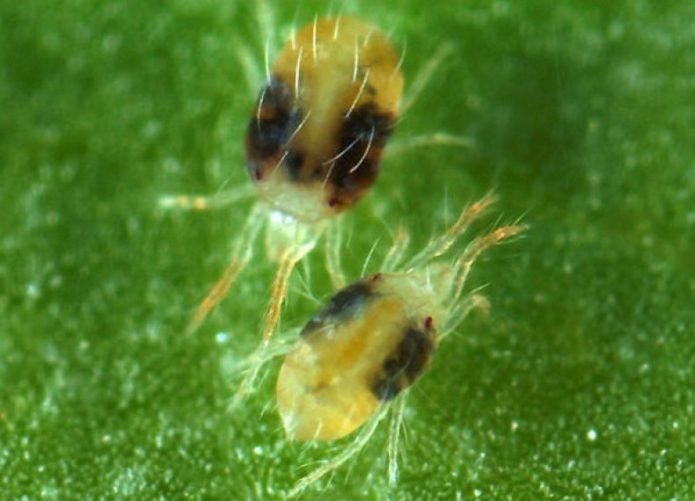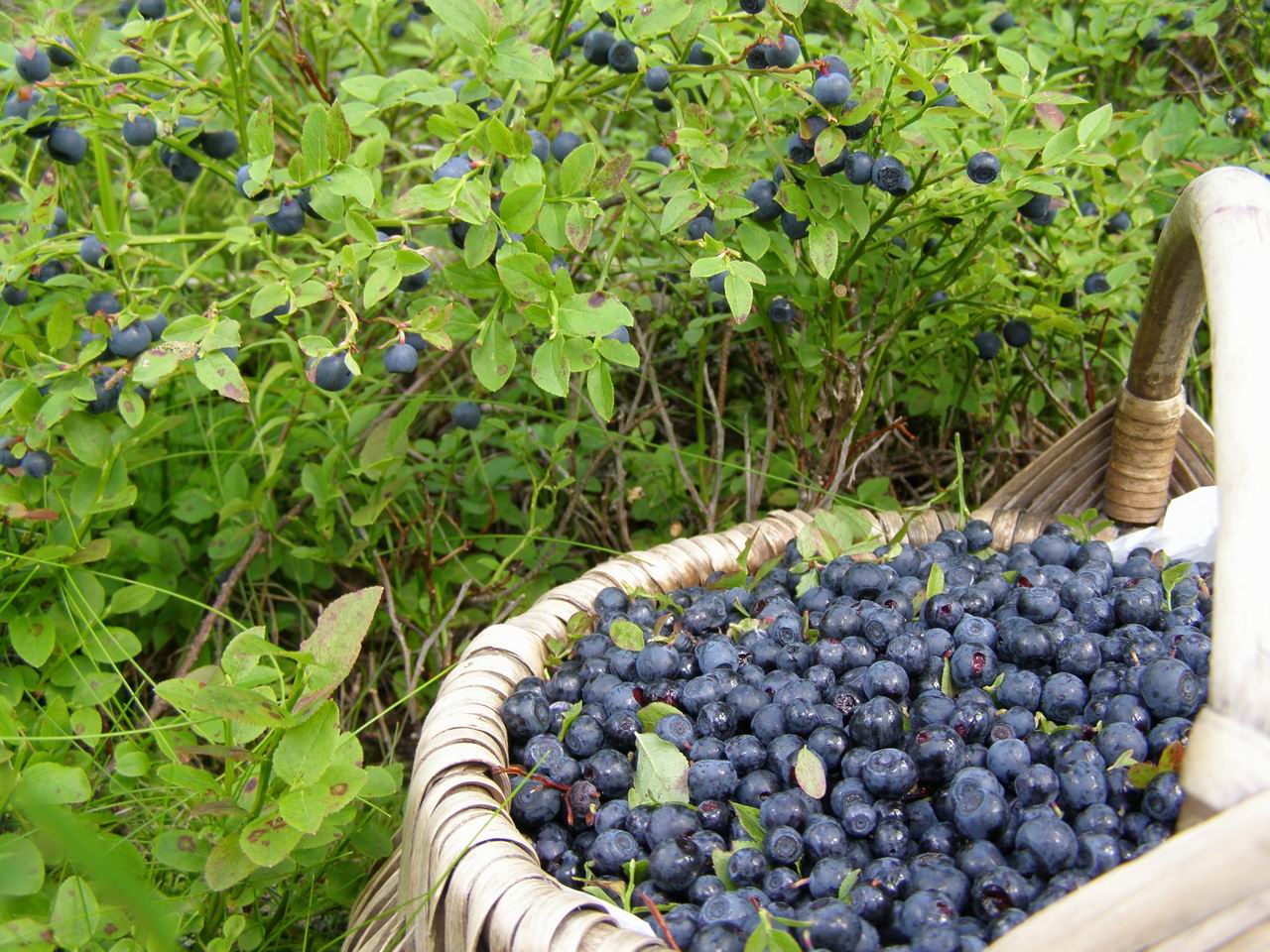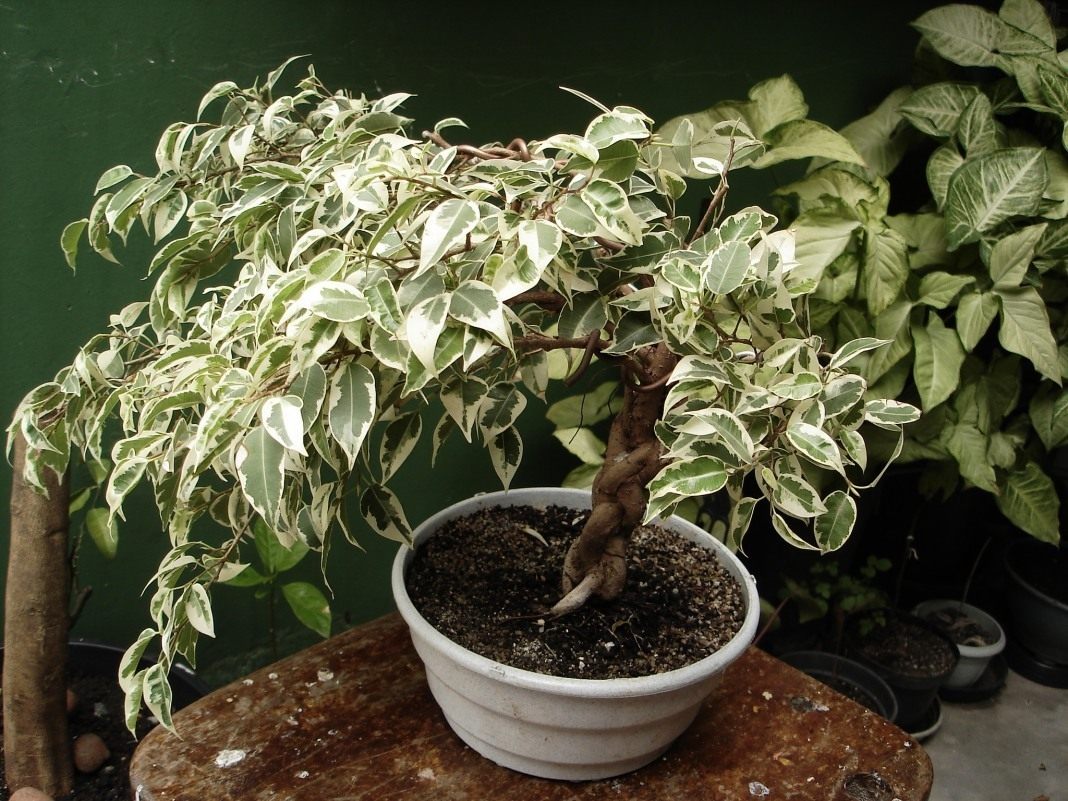Bouvardia is an evergreen flowering plant from the Marenov family. It comes from Central America and Mexico. In the Russian climate, it is grown mainly at home, in greenhouses and botanical gardens. The flower is able to bloom effectively and for a long time only for two seasons in a row, and then it is rejuvenated by reproduction.
Content
Plant features
At home, bouvardia is grown mainly as a biennial plant. This is due to the fact that in the third year of growth, the buds are no longer laid, and for the sake of foliage it is irrational to keep the flower. But this minus is fully compensated by the long flowering period, which begins in May and ends in early December.
Bouvardia is quite capricious regarding the conditions of detention, especially the temperature regime - it equally does not tolerate overheating and hypothermia. Therefore, it will not be easy for a novice florist with such a plant, since the room will need to constantly maintain the temperature and other indicators within certain limits.
Of all the available species of this plant in indoor cultivation, the home bouvardia is most in demand. It stands out for the variety of flowers in bloom and color. But this does not prejudice the dignity of other members of this genus. All bouvardia varieties emit a pleasant aroma during flowering, and the buds are so attractive that they can transform any interior. Since bouvardia is extremely thermophilic, it is realistic to grow it in Russian gardens only in regions with an Asian climate and only in summer. Therefore, it is a frequent guest on home windowsills and balconies.
And also the bouvardia is grown for cutting. Florists use these flowers to compose wedding bouquets, because the buds look beautiful even when closed and are collected in large-scale dense inflorescences. Cutting the stems is carried out as soon as 3-4 flowers open on them. With a systematic water change, such a bouquet retains its freshness for up to 3 weeks.
If you see a bouvardia in a dream, then this is a harbinger of something new in your personal life. Most likely, such a dream predicts a wedding or a meeting with your other half.
Common home types of bouvardia with a photo
The genus Bouvardia has about 30 species. The most popular are the following:
- Smooth bouvardia is a perennial up to 60 cm high, forming a dense leaf rosette. His leaves are grouped in three pieces or arranged oppositely. Dense thyroid inflorescences form on the tops of the shoots. The plant blooms with tubular flowers 3-4 cm long, which consist of four welded petals.On the outside they are salmon-colored, on the inside - red.
- Long-flowered bouvardia is a tall variety that can grow up to 90 cm. It has long thin shoots, so it is often cut for making bouquets. Its foliage is oblong, the leaves are opposite. Lush inflorescences of white or pink color appear in their sinuses.
- Bouvardia home is a compact specimen, which differs from other varieties in smaller foliage. Its leaves are ovoid and toothed along the edge, up to 5 cm long. The plant blooms with simple or double flowers, collected in inflorescences like a ball.
- Bouvardia yellow is a plant that grows up to 1 m tall. It blooms in double yellow inflorescences. Lanceolate foliage is no less attractive.
- Jasmine-flowered bouvardia is a dwarf representative that blooms in winter with snow-white bell flowers. It became famous for its fragrant aroma that resembles jasmine.
Reproduction methods
Bouvardia reproduces in several ways:
- cuttings;
- dividing the bush;
- seeds;
- root processes.
Cuttings
This method is preferred for mass propagation, often practiced in greenhouses. But at home it is also acceptable. Cuttings are harvested in early spring, when the plant comes out of dormancy.
Sequencing:
- From strong shoots, cut into pieces 10-15 cm long. Each should have 2-3 living internodes.
- Twigs are planted in separate pots for 2-3 pieces. at a distance of 5–6 cm.
- At first, they are kept in greenhouse conditions (covered with glass or plastic caps), and then, using ventilation, they are accustomed to the standard greenhouse air.
- At the end of May, the planted cuttings are rearranged in a cool room and transplanted up to three times during the summer period. At the same time, they use the transshipment method, and a nutrient mixture of humus, sand and leaf compost, taken in equal proportions, is used as soil. Every day, a greenhouse or greenhouse is opened to ventilate and accustom plants to natural light.
- Shortly before the onset of the first autumn cold snap, the bouvardia is transferred back to a warm room, where it hibernates.
- The following spring, fully rooted cuttings are transplanted into garden beds (in regions with a warm climate) or in separate pots. But for the winter they are returned to indoor or greenhouse conditions.
- In the second year, bouvardia is planted in open ground together with containers.
With single reproduction at home, it is easier and faster to germinate cuttings in water. Cut off shoots in such an environment take root after 3-4 days. As soon as they grow 1 cm in length, the cuttings are transplanted into the ground.
By dividing the bush
Among flower growers, this method is considered the simplest. Only with it, the plant does not renew itself, so you can not wait for flowering. They resort to a similar option with a strong growth of bouvardia. They act as follows:
- The plant is carefully removed from the pot and the soil is shaken off from the roots.
- Cut the root ball into several pieces with a sharp knife.
- Each part is planted separately in a nutrient soil.
Further care of the plantings consists in regular watering and maintaining the temperature regime within 25 ° C. It is recommended to add any growth stimulant (for example, Kornevin) to the irrigation water in a ratio of 1:10.
The less the root system is damaged during transplantation, the faster the plant will take root in a new place.
Seeds
For seed reproduction of bouvardia, a sand-peat soil mixture is prepared (the components are taken in equal proportions). The optimum temperature for germinating seedlings is 19–22 ° C. After sowing, the box is covered with glass or foil and placed in a dark room. Every day, the soil with the seeds is sprayed with warm water from a spray bottle and the greenhouse cover is slightly opened for ventilation. With the appearance of the first shoots, the container is moved to a well-lit place, but protected from direct sunlight. They start picking plants as soon as 2-3 true leaves are formed on them.
Root processes
The technology of propagation of bouvardia by root suckers:
- In the process of transplanting, the plants are cut off from the root of the shoots with several buds on the surface.
- The sections are treated with coal dust.
- The cuttings are buried in wet sand and covered with glass. It is harvested as soon as the first shoots appear.
- The cuttings are kept in the sand until full germination, then transplanted into ordinary soil.
At first, it is important to observe young plants - they are not waterlogged and protected from direct rays.
Table: optimal conditions for keeping bouvardia depending on the season
| Season | Temperature | Humidity | Illumination | Location |
| Spring Summer | + 20-25 ° C | At least 60% (this is necessary to stimulate flowering) | Scattered, shaded from the midday heat | It is ideal to place the plant on western or eastern windowsills. Shading will be required on the south side, supplementary lighting on the north. In warm weather, it is preferable to take the flower outdoors |
| Autumn winter | + 10-12 ° C | Within 40% | When there is a lack of light, the plant is illuminated with phytolamps |
Care
For this tropical plant to fully adapt to the Russian climate, it is necessary to provide it with appropriate care.
Watering
During the active growing season of bouvardia, moderate watering is required.... It is important not to allow stagnation of water in the pan, which leads to root rot. The frequency of watering varies depending on the intensity of drying of the upper soil layer. In winter, the plant continues to be moistened, but less intensely. The main thing is that the earthen lump does not completely dry out, since a prolonged lack of moisture leads to the death of the bouvardia. It will be enough to moisturize it once a week. Water for irrigation is preliminarily defended for 3-4 days at room temperature. In summer it is advisable to use rainwater.
To maintain high humidity in the room, it is recommended to install a special device or mini-fountains. In summer, bouvardia is sprayed daily, in winter - no more than three times a month.
Top dressing
Bouvardia is fed throughout the growing season 1-2 times a month. Any complex mineral compositions for flowering home flowers, which contain nitrogen and potassium, are suitable. At the end of summer, they switch to phosphorus fertilizers. Since autumn, the plant is completely stopped feeding due to its transition to the resting phase.
Pruning
Pruning plants are resorted to after flowering or in early spring. This procedure is necessary to stimulate the build-up of green mass. After flowering is complete, the shoots are shortened by a third along with wilted buds. In this way, you can give any form to the culture, it all depends on the imagination of the grower.
Transfer
If the bouvardia is grown for cutting purposes, then there is no need for its periodic transplant. Those who keep the flower as a perennial should replant it as needed - when the plant grows strongly and it becomes cramped in the old pot. Usually, this procedure is resorted to once every 2 years.
You can buy ready-made soil for planting (universal composition for flowering). It must be air and moisture permeable.If preference is given to a home-made soil mixture, then you will need to combine the following components in an equal ratio:
- garden land;
- peat;
- coarse sand.
The pot is picked up more than the previous one. A drainage layer (1–1.5 cm thick) of perlite or expanded clay is poured onto the bottom, then it is sprinkled with earth. The root ball of the plant is removed together with the soil and transferred to a new place, the required amount of soil is poured along the edges. After the completion of the work, the flower is watered.
Flowering period
To prolong the flowering period, wilted buds must be plucked immediately. The plant itself is placed in a room with a moderate temperature (20-22 ° C) and shading from the sun. It is also important to protect the flowering bouvardia from drafts. Do not forget to monitor the moisture content of the soil, as drought leads to a premature discharge of not yet blossoming buds.
Diseases and pests
Bouvardia, like other indoor plants, tends to get sick from time to time. The most common diseases:
- Chlorosis - develops when contaminated water is used for irrigation. A clear symptomatology of plant damage is yellowing of the foliage and its premature discharge. To prevent this, it is necessary to water the plant with exclusively settled and clean water. And it is recommended to feed the flower with iron-containing fertilizers.
- Root rot is a disease characterized by the development of pathogenic microflora on the roots. As a result, they start to rot. This is due to improperly organized watering. To save the plant, you should dig it up and transplant it into a fresh substrate, but first cut off the damaged areas on the roots.
Of the pests, aphids and spider mites pose the greatest danger to bouvardia.... They usually move to a flower from nearby plants. A clear sign of flower damage is the covering of leaf plates with yellow spots, which can lead to complete drying of the shoots. You can get rid of pests with the help of insecticidal preparations: Fitoverm, Afik, Aktellik, Bordeaux mixture.
From folk remedies against aphids, the use of soapy water or onion infusion is effective (1 chopped onion head is infused for 5-6 hours in a liter of water). They wipe the plant with one of these means, then wash it under warm tap water. It is important when processing leaf plates with soapy water not to touch their back side, which can harm the plant.
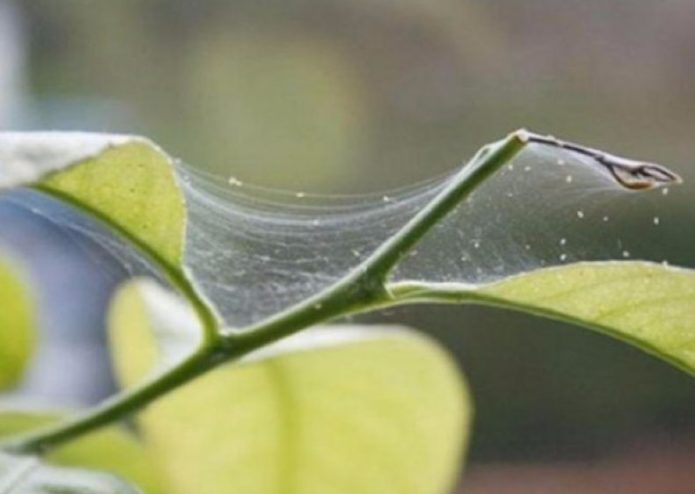
Signs of the appearance of a spider mite on bouvardia are cobwebs and small black specks on the leaves.
Spider mite countermeasures will depend on the extent to which the plant is affected. If the pest has settled not so long ago, then it is enough to wipe the leaves with a damp cloth. When the area of distribution of the tick is large, then they act as follows:
- The damaged leaves are removed.
- All cobwebs are removed from the plant.
- They buy rosemary oil at the pharmacy and prepare a solution from it: for 1 liter of water - 1-2 drops of ether.
- The crown is sprayed with the resulting product.
Bouvardia is considered a universal flower among florists. It will organically fit into any interior and decorate a balcony or loggia in the summer. And if the basic rules of care are followed, there will be no particular difficulties during plant growth.
